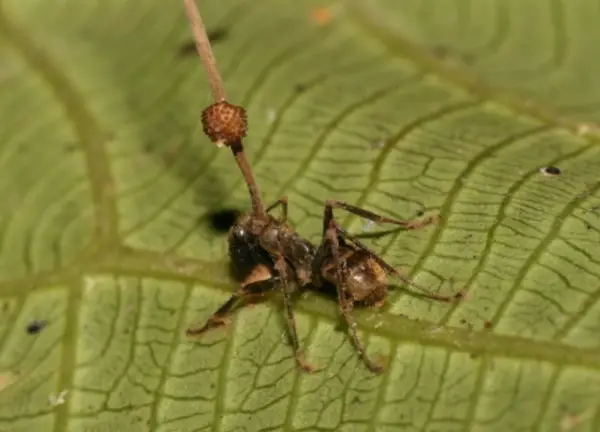This Zombie Fungus Takes Over Ant’s Bodies And Then Controls Their Minds
Tags: opinion

The methods used by the zombie fungus are quite complex and way more sinister than anyone suspected.
For this story, we look at Brazil and delve deep into its forests. Look for some leaves that are hanging near the floor of the forest. When you turn it over and look underneath, you might find a tiny ant that is hanging onto the leaf’s central vein. Its jaws are shut close and it’s imminent that its life is over. The body of this ant belongs to the Ophiocordyceps unilateralis, also known as the zombie fungus.
How Does The Zombie Fungus Infect The Ant?
The Zombie fungus infects the ant and grows inside its body. It drains all its nutrients and hijacks its mind.
READ: ZOMBIE APOCALYPSE? HOW GENE EDITING COULD BE USED AS A WEAPON – AND WHAT TO DO ABOUT IT
After a week or so, it forces the ant to leave its nest and climb up a plant stem. The ant stops climbing after it reaches approximately 25cms (the zone that has optimum temperature and humidity for the fungus to survive). It forces the insect to lock its mandibles on the leaf and then send a stalk through the head of the ant, which grows into a bulb-like capsule full of spores.
The ant is basically overhanging over its colony, then, and these spores fall down and zombify the other ants, turn by turn.
The Obsession With The Zombie Fungus
Popular culture has caught up with this zombie fungus and is the main organism in the game, The Last Of Us. David Hughes is obsessed with this fungus and has been studying them for years. He is an entomologist at Pennsylvania State University and wants to learn how they control their puppets. His recent experiments have shown that it is scarier than what was first perceived.
Maridel Fredericksen, who is Hughes’ student, used a microscope to cut the infected carpenter ants into slices (50nm thick) and scanned the slices. She collected all the images and created a 3-D model to find out which pieces were the ant’s and which bits had the zombie fungus. It took her 3 months to mark up one muscle.
How The Fungus Infects The Ant, As Per The Researchers
When the zombie fungus entered the insect, it existed as a single cell that floated around the bloodstream while budding off new pieces of itself. These cells then start to work with one another and connect by constructing short tubes. They then communicate with one another and exchange nutrients, in this way.
These fungi start invading the host’s muscles by penetrating the muscle cells or growing into the spaces between.
Hughes’ team observed another parasite that infects acts fatally but does not manipulate their minds. It spread into the muscle cells but does not form tubes or wire itself into larger networks. His team also found out that these fungi can manipulate the insect without physically touching the brain. These fungal cells infiltrate the ant’s body but leave its brain untouched.
READ: WOMAN ACTS LIKE ZOMBIE AFTER BAR REFUSED TO LET HER IN FOR NOT WEARING A FACEMASK (VIDEO)
Charissa de Bekker, who works at the University of Central Florida stated that “If such parasites were merely invading and destroying neuronal tissue, I don’t think the manipulated behaviors that we observe would be as compelling as they are. Something much more intricate must be going on.” She added that these zombie fungi secrete a plethora of chemicals that influence the brain without initiating any contact.
Final Verdict On The Zombie-Ant Fungus
So, here we have a fungus that invades a host’s body and uses that body like a talking machine to speak to one another while influencing the brain.
Once an infection is underway, Hughes says that the neurons in the ant’s body, the ones that give its brain control over its muscles, start to die. Hughes suspects that the fungus takes over control and effectively cuts the ant’s limbs off from its brain and inserts itself in place while releasing certain chemicals that force the muscles there to contract.
SUPPORT US ON PATREON AND GET ACCESS TO OTHER EXCLUSIVE CONTENT, CLICK HERE TO LEARN MORE
FOLLOW MIKE ON INSTAGRAM FOR MORE: @MIKESYGULA
Image credit: David P. Hughes, Maj-Britt Pontoppidan, CC BY 2.5, via Wikimedia Commons

Leave Comment: